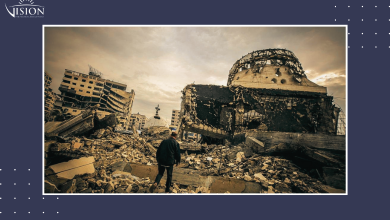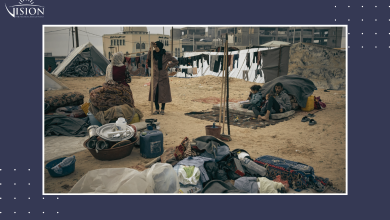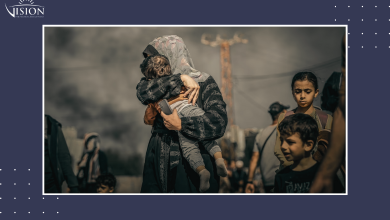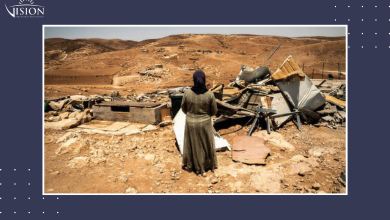Overview of Occupation Army Violations During January and February 2025
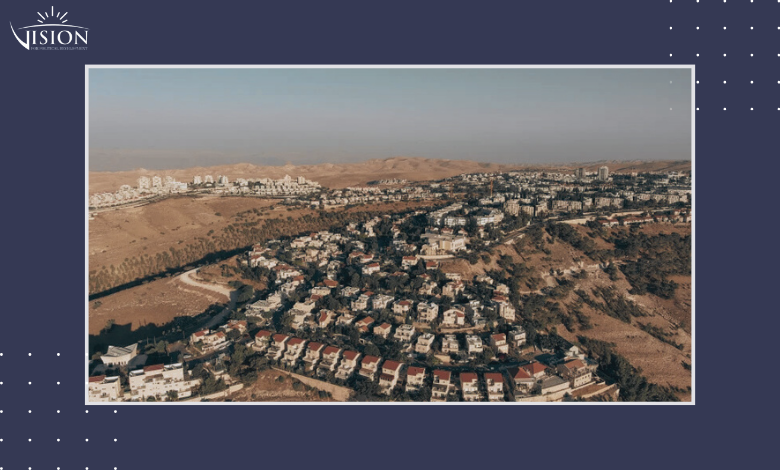
Saida Zaarir
In January 2025, a ceasefire came into effect in Gaza, as part of a three-phase agreement that included prisoner exchanges and the return of displaced Palestinians to the northern Gaza Strip after the withdrawal of Israeli forces. Days after the ceasefire, the occupation launched a military operation ‘Iron Wall’ in the Jenin refugee camp in the northern West Bank, followed by another operation under the same name in the Tulkarem and Nour Shams camps.
The following summary outlines the most prominent attacks carried out by the Israeli occupation forces and settlers against Palestinian citizens and their land during the months of January and February 2025. This report is based on information from the Palestinian Monitoring Group of the Negotiations Affairs Department of the PLO, the United Nations Office for the Coordination of Humanitarian Affairs (OCHA), the Palestinian Authority’s Wall and Settlement Resistance Commission, Monitoring Israeli Colonization Activities in the Palestinian Territories (POICA), and the organization Peace Now.
The Genocidal War on the Gaza Strip
On January 19, a ceasefire agreement in the Gaza Strip came into effect, after 470 days of genocide waged by Israel since October 7, 2023. The attacks resulted in the martyrdom of 47,348 Palestinians whose bodies reached hospitals, and left 111,761 civilians critically injured. In addition, 14,222 martyrs remained missing under the rubble, and the remains of at least 2,840 people have not been found at all, as reports from the Palestinian Civil Defense claim that their bodies were incinerated due to Israel’s use of chemical weapons that generate extremely high levels of heat.
Among the martyrs were 12,316 women and 17,861 children — 214 of whom were born and killed during the war. 808 of the child victims were under one year old. 44 children died due to malnutrition and lack of food, and 13 others died from severe cold in tents for the displaced.
According to data from the Palestinian Ministry of Health in Gaza, the occupation annihilated 2,092 Palestinian families, killing all 5,967 members, while 4,889 Palestinian families were annihilated, with only one member remaining, and the number of martyrs exceeded 8,980 martyrs.
In a more comprehensive breakdown of martyr data, the statistics showed that 1,155 martyrs were medical personnel, 99 civil defense personnel, 377 humanitarian aid workers, 205 journalists, 736 humanitarian aid workers and police, 12,800 students, 760 teachers and educational staff, and 150 scientists and academics.
It is estimated that 20 percent of the population of the Gaza Strip suffers from permanent disabilities, with about 4,500 amputations, 18 percent of which were performed on children.
In terms of material losses caused by the war, the destruction in the Gaza Strip reached 88%. Approximately 450,000 housing units were damaged, along with 1,661 educational facilities—representing 95% of school and educational buildings. Additionally, 34 hospitals, 80 health centers, 212 health institutions, and 191 ambulances were put out of service. Furthermore, 216 government buildings and facilities were destroyed, and another 60 were severely damaged.
Infrastructure damage exceeded 70% of water, electricity, and sewage networks in northern Gaza, reducing water availability to just three litres per person per day. In Gaza City, the only water desalination plant supplying the northern and western neighbourhoods was 90% damaged.
A total of 3,725 industrial facilities were affected, 2,000 of which were completely destroyed. In the commercial sector, 23,000 establishments were damaged, including 12,583 that were entirely destroyed. In the tourism and heritage sector, 229 tourism facilities were damaged, 111 of which were completely demolished, along with damage to 291 archaeological sites.
During the ongoing genocide, 1,129 mosques and 3 churches were destroyed, one of which was completely demolished. The occupation also destroyed 19 cemeteries and stole hundreds of bodies from them. Additionally, 1,062 civil society, sports, and cultural institutions were damaged.
As of December 1, 2024, the amount of rubble left by the war in Gaza totalled 50,773,496 tons, representing a 17-fold increase compared to the combined rubble from all previous Israeli wars on Gaza since 2008.
During the period covered by the report, the first phase of the Gaza ceasefire agreement and prisoner exchange deal began and concluded on February 27, with the release of 1,135 Palestinian detainees in exchange for 25 Israeli captives and the remains of 4 others, in addition to the Palestinian resistance releasing 5 Thai prisoners.
Between the beginning of the ceasefire on January 19 and February 25, 722 bodies were recovered from under the rubble in areas that had previously been inaccessible due to the Israeli attacks. Meanwhile, 18 Palestinians were killed by Israeli army firing between February 17 and 25.
Key Statistics of Violations Committed by the Occupation Forces in the West Bank and Jerusalem
Martyrs and Wounded:
During this period, 94 civilians were martyred, including 16 children, 3 detainees and 3 women, with Jenin governorate recording the highest number of martyrs with 42 martyrs, followed by Tubas governorate with 18 martyrs, and Tulkarem with 14 martyrs. Of the martyrs, 39 were killed by the Israeli army in assassinations and 21 during incursions into Palestinian cities and villages. At least 356 civilians were injured, including 66 children, 8 women and a journalist.
Arrests and Raids on Residential Areas:
The Israeli occupation forces arrested 1,823 Palestinian citizens in the West Bank and Jerusalem, including 64 children, 9 women, 5 university students and individuals with special needs. The highest number of arrests occurred in Hebron with 377 cases, followed by Nablus with 225 detainees, then Ramallah and Tulkarem with 210 each, Jenin with 193, and Jerusalem with 150. The remaining arrests were distributed across Tulkarem, Qalqilya, Tubas, Salfit, Bethlehem, and Jericho.
According to data from the Israeli Prison Service as of February, the number of Palestinian prisoners reached 9,846, including 3,369 administrative detainees held without trial. These figures do not include prisoners from the Gaza Strip detained since October 7, 2023.
The Israeli army carried out 2,766 raids on various Palestinian residential areas across the West Bank and Jerusalem. The highest number of incursions occurred in Nablus Governorate with 477 raids, followed by Ramallah with 462 raids, while the remaining operations were distributed across the governorates of Jerusalem, Jenin, Tubas, Tulkarem, Qalqilya, Salfit, Jericho, Bethlehem, and Hebron.
On January 21, the Israeli army launched a military operation in Jenin, involving ground forces, helicopter fire, and airstrikes. The operation later expanded to include the refugee camps in Tulkarem and Nur Shams, and by the end of February, it had entered its sixth week, making it the longest military operation in the West Bank in nearly two decades.
The operation resulted in the displacement of tens of thousands of Palestinians from the Jenin, Tulkarem, and Nur Shams camps. On February 18, Israeli forces informed residents of 41 homes in Tulkarem and Nur Shams camps to remove their belongings in preparation for demolition. Reports indicate that demolitions in the three camps are ongoing, though no accurate statistics on the number of homes destroyed have yet been released.
The operation has caused severe damage to infrastructure, including water, sewage, communications networks, and roads.
Demolition of Houses and Facilities:
In January, the occupation demolished 78 Palestinian homes and 38 commercial facilities in the West Bank and Jerusalem, including sheep barns, agricultural rooms and other commercial facilities. In February, the demolitions escalated to 114 homes and 42 commercial facilities. Most of the demolitions were concentrated in Jenin governorate, with 73 demolished homes and structures, followed by Hebron governorate with 61 demolished homes and structures, and Tulkarem with 30 demolished homes and structures.
According to the latest statistics covering the months of December and January, the military operations in Jenin refugee camp caused widespread damage to homes and infrastructure in the camp, with some 180 homes damaged, including some 50 homes damaged during an operation carried out by the Palestinian Authority (PA).
According to UNRWA, the majority of residents in the Jenin, Tulkarem, and Nur Shams refugee camps have been displaced, turning the camps into deserted areas. By the end of January, Jenin Governorate became the second most affected area by displacement operations in the West Bank, with 1,500 displaced people. Tulkarem Governorate recorded the highest level of displacement, with around 2,050 Palestinians displaced due to Israeli military operations. The total number of displaced people across the West Bank reached 3,600 Palestinians, including 1,400 children, mainly due to the demolition of Palestinian homes, accounting for 42% of the documented displacement cases. These figures do not include those displaced in February.
In mid-January, an Israeli court issued an order to evacuate five Palestinian homes in the Batn al-Hawa neighborhood of Silwan, south of Jerusalem, within six months, leading to the displacement of 27 families consisting of 131 individuals, most of whom are children. The Batn al-Hawa neighbourhood has around 700 Palestinian residents facing the threat of displacement under a discriminatory law that allows settlers to reclaim homes they lost in the 1948 war. Meanwhile, the same law states that Palestinians who were displaced and lost their homes in the same war are not eligible to reclaim them.
It should be noted that since 1967, the Israeli authorities have confiscated about a third of East Jerusalem’s land, about 20,000 dunams (equivalent to 20 km2), to build 55,000 new housing units for settlers.
On January 8, occupation forces occupied a house under construction near the entrance to Jalazoun refugee camp and turned it into a military outpost.
Land Confiscation and Demolitions:
During January, Israeli authorities confiscated 284.788 dunams through four expropriation orders. The first order seized 257.594 dunams of land from the villages of Jaba’, Kafr Aqab, Mikhmas, and Qalandiya north of Jerusalem, aiming to expand Route 45. The second order confiscated an additional 4.694 dunams from the same area.
On January 20th, Israeli authorities issued a decision to seize 15 dunams of land around the al-Za’aim military checkpoint and 7.5 dunams from the village of Husan.
In February, Israeli authorities confiscated 13,206 dunams and issued nine military orders — three of which were for “seizure orders”, while the other six allocated land for settler grazing.
The breakdown includes:
- February 18, 2025: A military order to seize 662 square meters of land from As-Sawiya village in Nablus, to build a settler road connecting the “Rehalim” settlement to the main road.
- Another order to seize 405 square meters of land from Naqura, Deir Sharaf, and Sebastia in Nablus, to construct a settler road linking the “Shavei Shomron” settlement to the main road.
- February 27, 2025: Israeli authorities issued a military order to seize 5 dunams and 218 square meters of land from the town of Tammun in Tubas Governorate, to build a road connecting the “Beka’ot” settlement to the main road.
- February 10, 2025: For the first time, the Israeli Civil Administration issued six military orders allocating 16,200 dunams for settler grazing activities, prohibiting Palestinian herders from using or accessing the land. The targeted areas include 2,600 dunams in Deir Ballut and Al-Lubban al-Gharbi in Salfit, 1,505 dunams in Kafr Malik and 4,900 dunams in Deir Jarir in Ramallah, 426 dunams in Jericho, and 8,700 dunams in Tubas.
The allocation of these lands for grazing is part of the Israeli government’s efforts to legalize 70 agricultural and pastoral settler outposts in the targeted areas. By the end of 2024, the number of unauthorized agricultural and pastoral outposts had reached 137, preventing Palestinians from accessing 489,000 dunams of their land.
Since 1967, Israel has forcefully allocated more than 680,000 dunams of Palestinian land, without granting landowners the right to object.
The occupation forces bulldozed tens of dunams of Palestinian lands across the occupied West Bank, especially the bulldozing and destruction of infrastructure in Jenin camp, Tulkarem and Nour Shams camps.
During the period covered by the report, Israeli forces and settlers uprooted approximately 1,611 trees in Hebron, Salfit, Bethlehem, Ramallah, Nablus, Jenin, and Jerusalem.
Settler Attacks:
The month of January witnessed an escalation in settler attacks on Palestinian villages and communities in the West Bank, amounting to 236 cases of attacks on Palestinian citizens, their properties and holy sites. In the month of February, settlers carried out an additional 152 attacks. These attacks included storming agricultural lands and cultivating them to claim ownership or destroying Palestinian crops and trees, systematic attacks on Palestinian villages and towns, shooting at homes and burning vehicles, as well as stealing and confiscating Palestinian property.
Settlement Expansion:
In January, Israeli authorities reviewed 31 zoning plans aimed at expanding settlements in the West Bank and Jerusalem. These plans included the construction of 943 new housing units on 9,881 dunams of West Bank land and 3,512 additional housing units on 441 dunams of land in Jerusalem.
In February, 27 zoning plans were introduced — 22 for the expansion of West Bank settlements, with half approved and half under review, along with 5 plans in Jerusalem, 3 of which were approved. The plans included the construction of 1,278 new housing units on 3,196.6 dunams of West Bank land and 1,406 new housing units on 49.88 dunams of Jerusalem land.
The plans reveal the Israeli authorities intent to expand the settlement of “Telem” built on the lands of the town of Tarqumiya in Hebron, by establishing a new settlement neighbourhood that includes 196 new housing units, on an area of 144 dunams of Palestinian citizens’ lands surrounding the settlement. The plans also indicate the allocation of 1,923 dunams of land from the village of al-Nabi Musa in Jericho for the expansion of the settlement of “Kalia”. The plans also call for the construction of a new settlement neighbourhood within the boundaries of the Jerusalem municipality, with 316 new housing units on 17 dunams of land in the “Kubaniya Umm Haroun” area.
In the end of January, the occupation authorities presented a project aimed at building 682 new housing units in three settlements: “Halamish, Metzad, and Bado’el. The proposed housing units will be concentrated in the settlement of “Halamish”, a settlement built on Ramallah and Al-Bireh lands since 1997, with 531 new housing units, thereby effectively doubling the current population of 1590 settlers. The proposal also includes 126 new housing units in the settlement of “Metzad” located on Hebron lands, and another 25 units in “Bado’el”, located west of Salfit.
On January 22, the Supreme Planning Council of the Israeli Civil Administration presented a proposal to build 184 new housing units in the settlement of Magdalim, built on the lands of Qusra, south of Nablus. This was preceded by a proposal to build 372 new housing units in the settlement of “Beitar Illit” built on lands south of Jerusalem. Also, on January 8, the occupation authorities discussed a plan to build 448 new housing units distributed in the settlements of “Geva Binyamin” with 356 housing units, ‘Karni Shomron’ with 68 housing units, ‘Beitar Illit’ with 23 housing units, and ‘Kochav Ya’akov’ with one housing unit.
In early February, the Supreme Planning Council discussed the construction of 655 new housing units in the settlements of “Kochav Yaakov” and “Be’er Yaakov,” which are built on Jerusalem land. On February 12, plans were presented to build 1,124 new housing units in three settlements: “Beitar Illit, Adora and Hananit, including 287 units to be built east of Adora on the ruins of Khirbet al-Taybeh, whose 55 residents were displaced due to settler violence in October 2023. The plans also include the construction of 561 new housing units in Beitar Illit settlement, in order to seize new areas of Wad Fukin town in Bethlehem, as well as the construction of 267 housing units in Hananit settlement, west of Jenin, in addition to the construction of 267 housing units in Hananit settlement, west of Jenin.
On February 19, the Supreme Planning Council discussed the construction of 894 new housing units in three settlements: “Telmon, northwest of Ramallah, Rimonim, east of Ramallah, and Beitar Illit, southwest of Jerusalem. The Israeli Civil Administration published a tender to build 974 new housing units in the settlement of Efrat, south of Bethlehem, which will increase the settlement’s population by about 40 percent. On February 26, the Supreme Planning Council discussed the construction of 1,170 new housing units in four settlements: “Givat in Bethlehem, where the largest number of the planned 756 new housing units are concentrated, which would expand the settlement 20-fold; Itamar southeast of Nablus; Shaare Tikva in Qalqilya; and Givat Ze’ev northwest of Jerusalem.
Since December 2024, the Supreme Planning Council has been holding weekly meetings to discuss the construction of hundreds of new housing units in settlements, especially after the need for the Israeli Defense Minister to approve settlement plans was eliminated. These weekly meetings aim to normalize settlement planning, minimize international public criticism, and accelerate the pace of settlement construction. The total number of housing units put forward since the switch to weekly approvals has reached 7,458 new housing units in just three months. It is estimated that 20,000 new housing units could be built by 2025 if the pace of settlement escalation continues at the current rate. This compares to 12,349 new housing units approved by the Supreme Planning Council in 2023 and 9,884 in 2024.
The current Israeli government’s new policy promotes the gradual annexation of Palestinian land in the West Bank and Jerusalem in flagrant violation of international law, tensions in the region.
In January, the Israeli Civil Administration announced its intention to expand the jurisdictional boundaries of the Geva Binyamin settlement municipality to include about 1,107 dunams east of Ramallah. The area includes the illegal settlement outpost of Bani Adam, as well as the bedouin community of Hizma, whose Palestinian residents were forcefully displaced in October 2023 following settler violence.
According to Peace Now, the expansion of the municipality’s boundaries aims to legitimize the illegal outpost. The establishment of such outposts and the violence caused by their settlers is not accidental, but part of an illegal and immoral policy adopted by the current Israeli government to expel Palestinians and confiscate their lands.
Since the current Israeli government took office, 24,759 dunams have been declared as state land, which is equivalent to almost all the land that has been declared state land since the Oslo Accords.
According to Peace Now, the Israeli authorities established 59 new settlement outposts, 8 of which were established in areas classified “B” for the first time since Oslo, and hundreds of kilometres of illegal roads were built for settlements, in addition to approving 9,884 new housing units and declaring 24,258 dunams as state land, which is half of what was declared from Oslo.
According to the organization’s report, the Israeli authorities decided to build five new settlements, in addition to working to approve five settlement outposts as neighbourhoods of existing settlements. The Israeli authorities funded the illegal outposts with 75 million shekels.
Since October 2023, 1,420 incidents of settler violence against Palestinians have been documented, 47 Palestinian communities have been displaced due to settler violence, 1,065 Palestinian structures have been demolished in the West Bank under the pretext of lack of licenses, 452 others during military operations, and 215 homes have been demolished in Jerusalem, also under the pretext of lack of licenses.


